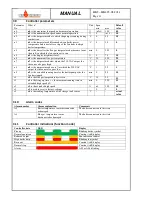
MANUAL
HK2 – HK4 25-08-2014
Page
14
c) Cleaning the heat exchanger pipes
Notice:
A poor quality fuel (too old, in decomposition phase, too much moisture..., will cause tar
deposits on tubes (incomplete combustion), with for consequence the difficulty to
remove the turbulators. A more frequently cleaning have to be done and a better fuel
shall be used as soon as possible.
1.3.13
Door silicone gaskets
After a few weeks of use, it might be necessary to re-tighten the loading and ash doors by
adjusting the hinge screws. The seal (a silicon covered glass robe) squeezes during the first
uses. Its waterproofness though guarantees the good function of the boiler. A non-
waterproof seal will harden and will have to be changed more often.
The rotating door handle makes a dynamic correction, which will ensure correct tightness as
compression of the robe after the first continues at smaller pace.
See the chapter on installation for the method and / or contact your heating-engineer.
The heat exchanger pipes are the principal
recuperation of energy. Located at the end of the flue
gas circuit, they will accumulate a little ash and soot.
Nevertheless, to conserve an optimum efficiency of the
boiler and good function, it is necessary to clean them
regularly. Having the boiler switched off manipulate
the handle in the front upper right corner. Make it a
habit every time before the boiler starts.
In the event of a sudden polluted boiler, it can be
necessary to make a more thorough cleaning of the
pipes. Open the access cover, take out the turbulators
and brush all the sides and each pipe from low to high
many times. Remounting and centering the cover and
take care to the mounting side.
Summary of Contents for HK2
Page 27: ...MANUAL HK2 HK4 25 08 2014 Page 27 3 8 Electrical connections ...
Page 33: ...MANUAL HK2 HK4 25 08 2014 Page 33 No text ...
Page 34: ...MANUAL HK2 HK4 25 08 2014 Page 34 No text ...
Page 35: ...MANUAL HK2 HK4 25 08 2014 Page 35 No text ...
Page 36: ...MANUAL HK2 HK4 25 08 2014 Page 36 Rev 02 010914 ...















































